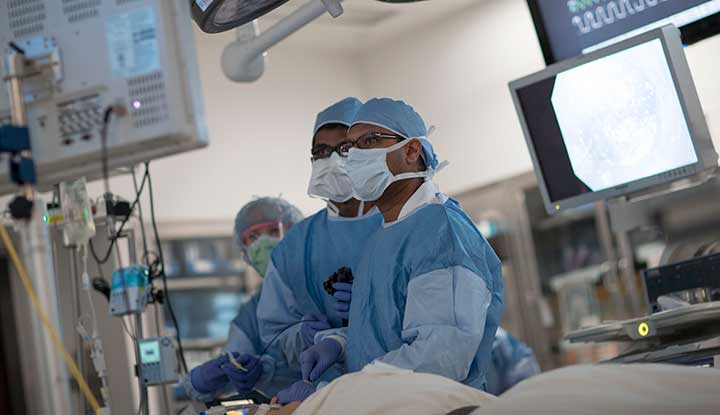Thoracic surgery can include a variety of operations in your chest (thorax). In addition to your heart and lungs, thoracic surgery can involve your esophagus, trachea or other areas. A heart valve repair, lung tumor removal or aneurysm repair in your chest all fall under the thoracic surgery category.
Advertisement
Cleveland Clinic is a non-profit academic medical center. Advertising on our site helps support our mission. We do not endorse non-Cleveland Clinic products or services. Policy

Image content: This image is available to view online.
View image online (https://my.clevelandclinic.org/-/scassets/images/org/health/articles/24201-thoracic-surgery)
Any operation in your chest (thorax) is thoracic surgery. While your heart is the best-known organ in your chest, thoracic surgery includes lung surgery and much more. It also includes surgery of your:
Advertisement
Cleveland Clinic is a non-profit academic medical center. Advertising on our site helps support our mission. We do not endorse non-Cleveland Clinic products or services. Policy
A surgeon can perform thoracic surgery using an open or minimally invasive approach. With open surgery, there’s a larger incision. With minimally invasive surgery, surgeons use smaller incisions and place a video camera through your chest.
With the video camera in your chest, surgeons use small, long instruments to perform the procedure through other small incisions. They can do minimally invasive surgery with handheld video cameras and instruments. The name for this is VATS surgery in the chest or laparoscopic surgery in the abdomen.
Surgeons can also do minimally invasive surgery with the assistance of a robot that holds the instruments and camera, but the surgeon still controls these.
Thoracic surgery includes any operation to treat an issue in your chest and upper abdomen, such as:
Advertisement
Coronary artery bypass grafting (CABG) and lobectomy (removing part of your lung) are the most common thoracic surgeries. CABG is the world’s most common heart surgery. In the U.S., surgeons perform about 200,000 CABG surgeries each year.
Surgeons performed more than 13,000 lobectomies in 2019 in the U.S.
Yes, many thoracic surgeries are serious. Your heart and lungs are very important organs, and they need to function well. Some people need complicated surgeries to fix more than one heart issue. Others may need a minimally invasive lung surgery. In either case, a healthcare team will be focused on working together to give you the best surgical outcome.
Depending on the type of operation you’re having, you may need blood tests before thoracic surgery.
For heart issues, other tests may include imaging or tests that measure your heart rhythm and function.
For lung issues, you’ll need imaging and tests that measure how well your lungs work (pulmonary function). A provider also may use one of several methods to take tissue samples from your lungs. They may ask you to walk up several flights of stairs or in a line for six minutes to predict your risk of complications.
After reviewing your test results, a thoracic surgeon can plan your surgery.
The following steps can help you prepare for thoracic surgery:
After you receive anesthesia in an IV to put you to sleep, you’ll get a breathing tube. Also, depending on the type of thoracic surgery, a machine may handle your heart’s and lungs’ functions for you during your surgery.
Your provider will:
Advertisement
After thoracic surgery:
Thoracic surgery can save or extend your life if you’re having a serious issue with your heart or lungs. Also, thoracic surgery can have a major impact on your quality of life by helping your heart or lungs work better. Thoracic surgery can help with difficulty swallowing or other issues that affect you on a daily basis.
Risks of thoracic surgery include:
Thoracic surgery recovery time varies depending on the type of operation you had. You may spend a week in the hospital after your thoracic surgery. But if you had minimally invasive surgery, you may need only three or four days to recover.
Advertisement
You may need a month or more to recover completely.
Depending on the type of thoracic surgery you had, you may not be able to drive for a month. Also, you may have limits on how much you can lift for six weeks after surgery.
Contact your provider if you’re having:
Thoracic surgery includes a wide variety of operations a provider performs in your chest. Procedures can range from straightforward to complex. Surgeons can use open or minimally invasive approaches, selecting the best option for your situation. Be sure to ask them if there’s anything you don’t understand about your procedure. Having more information about it can make you feel more comfortable about having surgery.
Advertisement
Learn more about the Health Library and our editorial process.
Cleveland Clinic's health articles are based on evidence-backed information and review by medical professionals to ensure accuracy, reliability, and up-to-date clinical standards.
Cleveland Clinic's health articles are based on evidence-backed information and review by medical professionals to ensure accuracy, reliability, and up-to-date clinical standards.
When you need heart surgery, you want the most experienced team on your side. Cleveland Clinic offers expert cardiology care and heart surgery.
